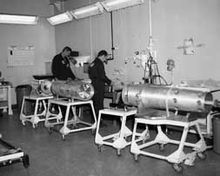Loading AI tools
U.S. nuclear weapons assembly facility From Wikipedia, the free encyclopedia
Pantex is the primary United States nuclear weapons assembly and disassembly facility that aims to maintain the safety, security and reliability of the U.S. nuclear weapons stockpile.[1][2] The facility is named for its location in the Panhandle of Texas on a 16,000-acre (25 sq mi; 65 km2) site 20 miles (32 km) northeast of Amarillo, in Carson County, Texas. The plant is managed and operated for the United States Department of Energy (DOE) by Consolidated Nuclear Security (CNS) and Sandia National Laboratories. CNS is composed of member companies Bechtel, Leidos, Orbital ATK, and SOC, with Booz Allen Hamilton as a teaming subcontractor.[3] CNS also operates the Y-12 National Security Complex in Tennessee, a manufacturing facility for nuclear weapons components.[3]

As a major national security site, the plant and its grounds are strictly controlled, and the airspace above and around the plant is prohibited to civilian air traffic by the FAA as Prohibited Area P-47.


The Pantex plant was originally constructed as a conventional bomb plant for the United States Army Air Force during the early days of World War II. The Pantex Ordnance Plant was authorized February 24, 1942. Construction was completed on November 15, 1942 and workers from all over the U.S. flocked to Amarillo for jobs.
Pantex was abruptly deactivated when the war ended and remained vacant until 1949, when Texas Technological College in Lubbock (now Texas Tech University) purchased the site for $1.[4] Texas Tech used the land for experimental cattle-feeding operations.
In 1951, at the request of the Atomic Energy Commission (now the National Nuclear Security Administration (NNSA)), the Army exercised a recapture clause in the sale contract and reclaimed the main plant and 10,000 acres (40 km2) of surrounding land for use as a nuclear weapons production facility. The Atomic Energy Commission refurbished and expanded the plant at a cost of $25 million. The remaining 6,000 acres (24 km2) of the original site were leased from Texas Tech in 1989.
Pantex was operated by Procter & Gamble from 1951 to 1956, Mason & Hanger from 1956 to 2001, and Babcock & Wilcox from 2001 to 2014.[5]
In 2010, the plant employed about 3,600 people and had a budget of $600 million.[6]

There has been perennial interest in whether conditions at the plant have led to health problems in its workers or the surrounding communities. In 1998, the Agency for Toxic Substances and Disease Registry documented a statistically significant incidence of increased cancer rates and low birth weights in some of the counties surrounding Pantex, but the counties closest to the plant (Armstrong and Carson) had no significant increase in cancer rates. The agency concluded that the plant was not likely to be associated with these findings.[4] A 2005 NIOSH study of cancer rates among Pantex workers over the timespan 1951–1995 found that they had a stastistically-significant increase in occurrence of prostate cancer and multiple myeloma with length of employment, leading the authors to recommend follow-up research to investigate whether the working conditions of those employees was the cause.[7] In 2013, the Amarillo Globe-News reported that some Pantex employees had been awarded financial compensation by the U.S. government after developing health problems that may have been related to depleted uranium or thorium exposure.[8]
In 1994, the EPA listed the plant as a Superfund site, having found toxic chemicals, including radionuclides, in over a hundred places in its soil and groundwater. This was due to improper waste management practices for the materials in question, like storing wastewater in unlined ponds, burying waste in unlined landfills, and burning waste in the open. Using techniques such as soil vapor extraction and bioremediation as well as changing institutional practices at the plant, the EPA oversaw a cleanup that they said made the site safe in the short term as of 2009, although their long-term cleanup of the site's perched groundwater is ongoing as of 2024.[9][10]
Labor troubles arose in 2007 following the implementation of stricter physical and performance requirements for armed security personnel following the September 11th attacks. The worker's union for the Pantex guards protested that the new standards were unfairly strenuous to middle-aged personnel nearing retirement.[12] In protest 500 guards walked off the job and went on strike in April 2007 and were replaced with a temporary guard force.[13] The strike ended with a negotiated settlement after 34 days. Guards also went on strike in a pay dispute in 1981, and unionized production and maintenance workers struck in 1970 and 2015.[14]
Seamless Wikipedia browsing. On steroids.
Every time you click a link to Wikipedia, Wiktionary or Wikiquote in your browser's search results, it will show the modern Wikiwand interface.
Wikiwand extension is a five stars, simple, with minimum permission required to keep your browsing private, safe and transparent.